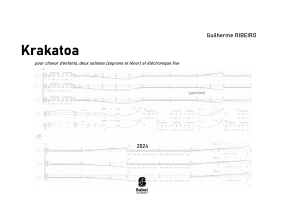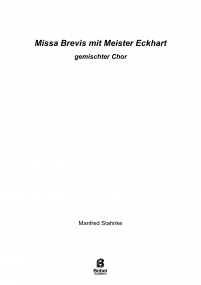Recherche avancée
I see you
Text by Claire Tipy.
ISMN : 979-0-2325-7645-9
- Identifiez-vous pour créer une liste
Based on my ‘micro-opera’ Vois for Soprano Saxophone, high voice and low voice, this piece extends on this intimate instrumentation, adds the fuller vocal resources of the choir and provides depth to the harmonic material with added voices.
This original work was performed at Festival d’Aix-en-Provence 2021 and was developed via zoom during the 2020 and 2021 Covid19 crisis.
This work explores the relationship of individuals living the dual life in person, connecting with breath, gesture, body language, and physical space, and the second world we are more and more starting to live in, in the dark, reflective mirror of the internet.
In this version the choir is divided into 3 voice groups - high, medium and low voices, and it is up to the individual, choir or conductor how to best divide and balance these groups. Due to divisi in certain areas, the minimum number of singers for this piece is 1 high voice, 2 medium voices and 1 lower voice.
Notes without a note head are to be sung freely, in a recitativo style.
The soprano saxophone part can also be played by a clarinet, cor anglais, oboe, alto saxophone or any equivalent woodwind instrument. T.T. denotes a shoring for a timbral trill.
This part could even be played by a violin, trumpet, horn etc if circumstances required.
The section 4 bars prior to figure A can be used as the basis for an improvisation, if desired. The improvisation is based on the material given, and so is a textural passage exploring the nature and timbre of breathing. The choir, conductor or individual singers are empowered to create their own music in this section.
Notes with the cross sign above them denote singing with hands over your mouth in a muffled manner. Notes with the o symbol determine singing without hands over the mouth. Sometimes a horizontal line is used to denote moving from one to the other, for example figure B where the higher voice/s moves from no hands on the mouth to hands over the mouth by the end of the word ‘vois.’ When moving the hands from the mouth the performer should try and achieve a graceful and dancerly way of bringing the hands off the face to add to the visual effect but to also produce a blossoming effect in the acoustic.
Sometimes a horizontal line with a small vertical line at the end is used, this is to indicate that the hands should be over the mouth, but not completely covering the mouth.
Choir
Soprano saxophone
Pages - 12







